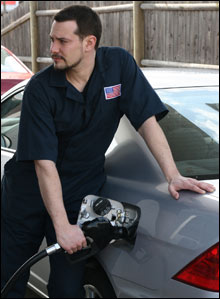
COOKIN’ WITH GAS: Eric Hofbauer likes to pump his own, thanks. |
“Jazz Week,” which runs April 26–May 4, tends to appropriate all events to its needs — if you’re playing, say, your regularly scheduled gig at Matt Murphy’s Pub this week, you’re part of Jazz Week. But the event, which is spearheaded by the non-profit collective JazzBoston, does beef up the jazz calendar: venues not used to jazz are urged to try it, with the promise of some free publicity, and others attempt the unique. Jazz pianist Pierre Hurrel is conducting a performance/demonstration called “How Jazz Happens” in an early show at the Regattabar on Monday, and the Boston Public Library is hosting a week of jazz-related lectures and panel discussions. And a big, multi-act benefit concert called “A Kaleidoscopic View of Jazz in Boston,” headlined by poet Robert Pinsky and percussionist/composer Rakalam Bob Moses, is set for May 3.There are other events that might have happened with or without Jazz Week but serve the cause well. The three-night stand of Eric Hofbauer and his Creative Nation Music label at the Lily Pad (April 30–May 2). And young alto-sax star Miguel Zenón’s concert at the Jorge Hernández Cultural Center (May 1).
Guitarist Hofbauer, 34, is the soul of DIY. He started Creative Nation a few years ago to front various projects — his own and others’ CDs as well as concerts. At the Lily Pad, he’ll play with his Infrared Band on April 30 (previewing their forthcoming Myth Understanding), the duo of Hofbauer and guitarist Garrison Fewell will play music from The Lady of Khartoum (May 1), and the trio of bassist Giacomo Merega, guitarist David Tronzo, and saxophonist Noah Kaplan will perform music from The Light and Other Things (May 2).

The Lady of Khartoum is a beauty that emerged as Hofbauer and Fewell discussed their disparate interests — Fewell’s world travels, Hofbauer’s teaching gigs, and “different musical techniques that bridge the cultural divide,” as Hofbauer tells me over the phone. So Fewell dragged a trunk of his world-percussion toys from Africa and the Middle East into a studio and Hofbauer joined him for a series of entirely improvised pieces. Although there was no plan, these “free” pieces do hover around tonal centers or ride on gentle rhythmic vamps. The extremes come in the way the duo doctored their instruments — Fewell’s electric, Hofbauer’s acoustic. There are also a few written pieces (including Monk’s “Let’s Cool One”). But the freely improvised pieces are impressive for their consistent mood. “We never said, ‘Oh let’s do the West African–sounding thing next,’ ” says Hofbauer. “Or, ‘Let’s really focus on the cross-cultural pollination of this music.’ It was much more natural — just grab some bells or something and just start and see what happens.”
The humorous, off-kilter “Dogon Delta Blues” came after “one of the more intense, introspective, modal type pieces. We wanted to do something drastic.” So Fewell attached some alligator clips and paper clips to his strings and Hofbauer put a business card under his to conjure a banjo. “Cajun Raven” began with Fewell vamping in F; that for some reason reminded Hofbauer of “Bye Bye Blackbird,” so he began to superimpose an oblique version of the melody on top, using an Altoids box as a slide. Ten percent of sales from this lucid, affecting CD goes to Mercy Corps.
Meanwhile, at the Hernández Center, alto-saxophonist Zenón, 31, will be working his latest for Marsalis Music, Awake, probably his most ambitious yet. Zenón has explored post–Greg Osby bop as well as the folkloric music of his native Puerto Rico, and he has a great working band — pianist Luis Perdomo, bassist Hans Glawischnig, and drummer Henry Cole. On Awake he adds a string section, not as a sweetener but as pungent counterpoint to his horn in the opening prelude. The album works like a suite through variations of different themes. When Zenón has Perdomo switch to Fender Rhodes, it’s not simply a ’70s funk signifier — he makes the most of its blurry, sub-aquatic timbre against the strings or his horn. When Zenón burns through an up-tempo number, his clarion tone shines brighter still. Even a transitional “free” passage with extra horns at the album’s midpoint eventually coalesces around a theme. Zenón could probably get by on his chops alone — instead he’s using form as a way to challenge himself and renew his music. That speaks well for the long haul.
Pop audiences always want to know what songs someone played; jazz audiences want to know how they played. But composer Carla Bley always thinks about song form even at her most far-reaching. At Scullers a week ago Wednesday, she played piano as part of her “Music with Legs” trio, which she named for the 1995 ECM album on which they first appeared as a band: Bley with her long-time companion Steve Swallow on five-string electric bass and Andy Sheppard on saxophones. And Swallow introduced the first number — a 25-minute suite — as “a long song.” Called “The National Anthem” (from 2003’s Looking for America), it used phrases from “The Star Spangled Banner” as transition points among its sections. It began with question-and-answer riffs between tenor sax and piano, then moved into shuffle rhythms, funk, free time, the mood cued with subtle key changes, where, say, the word “night” would have been in the lyric. A “political” work, it refused to declaim, instead asking questions, Bley ending it with a single-note line that stopped and hung on the word “home,” unresolved.